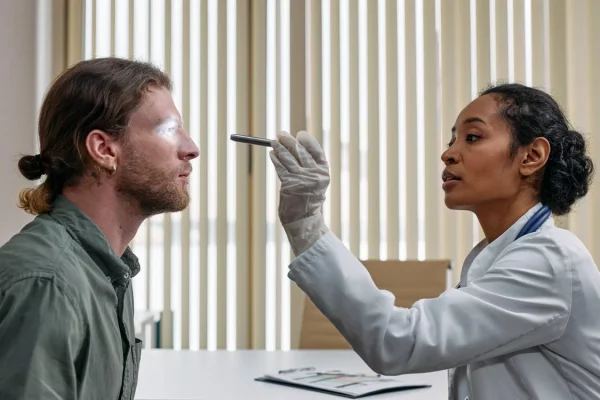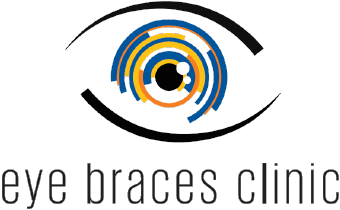ORTHOKERATOLOGY (ORTHO K) CONTACT LENSES
Contact lenses and glasses are commonly used to correct a variety of refractive problems, including nearsightedness, farsightedness, astigmatism, and presbyopia.
Wouldn’t it be wonderful though if you could improve your vision without the constant need to wear glasses and contacts?
It may seem unimaginable, but it is a reality today.
Read more to find out about Orthokeratology Lenses.
WHAT IS ORTHOKERATOLOGY?
Ortho K is a corneal reshaping technology that temporarily corrects your vision through the night.
Often referred to as “Eye Braces,” Ortho K Lenses remodel the front surface of the eye gently, similar to how aligners and braces correct teeth. It’s a non-surgical and reversible procedure which makes it a great alternative to laser correction surgery.
HOW DOES ORTHO K LENSES WORK?

Ortho K lenses are a special kind of rigid breathable contact lens.
Each pair of contact lenses are tailor made to every individual’s visual needs using cutting-edge lens design technology. The lenses gently reshape the front surface of your eye (cornea) so that when you wake up the next day, you can enjoy perfect or near-perfect vision.
The effect of the lens wears off after 48-72 hours, and the cornea gradually returns to its natural form. For maximum vision correction, you are encouraged to wear the Ortho K lenses for at least 6 hours each night, and ideally 8 hours.
CAN I WEAR ORTHO K LENSES?
Ortho K is commonly used to reduce or slow the progression of myopia in children but there are no age restrictions for wearing Ortho K contact lenses. Adults who have an active lifestyle or are not suited for corrective surgeries like LASIK may find Ortho K an ideal option to regain good vision without the use of glasses or day contact lenses.
Ortho K lenses are often prescribed to correct refractive errors such as:
- nearsightedness
- astigmatism
- farsightedness
- presbyopia
The type and degree of refractive error that Orthokeratology can address varies from case to case.
Orthokeratology lenses can usually correct nearsightedness up to -6.00 diopters (D) but the best way to determine if you are an eligible candidate for wearing Ortho K lenses is through a consultation.
Our skilled Orthokeratologists in Eye Braces Clinic has helped over 3,000 patients over the years, with one of them a member of the American Academy of Orthokeratology & Myopia Control.
Book a consultation today to begin your journey to clearer vision with Eye Braces Clinic.
DO I NEED ORTHO K LENSES?
Ortho K lenses allow individuals to experience clear vision without the constant need for spectacles or daytime contact lenses.
Ortho K is most suitable for:
- children with myopia
- individuals experiencing dry eyes from regular contact lenses
- individuals working in unsuitable environment
- individuals with sensitive eyes
- individuals with active lifestyles
- individuals looking for non-invasive vision correction
If you’re still unsure, rest assured that our skilled optometrists will review your lifestyle, comfort and concerns to ensure that you get the best fit!
WHAT TO EXPECT FROM WEARING ORTHO K LENSES

Orthokeratology is a highly specialised form of contact lens fitting, and not all eye specialists who fit contact lenses also fit Ortho K lenses. As all Ortho K lenses are individually designed for each eye, the fitting process may be complicated.
At Eye Braces Clinic, we guide you through the entire journey.
The process of fitting Ortho K lenses usually begins with measuring the eye surface with a topograph. The topograph data is then used to design the lens based on the shape of the cornea.
Your Orthokeratologist will then finetune the design to create a lens that will keep you comfortable all night. A series of temporary lenses may be needed until your accurate prescription is recorded.
You should be prepared for 4-6 visits over a 3-6 month period depending on the complexity of the case to achieve maximum vision correction.
ORTHOKERATOLOGY (ORTHO K) FAQs
Ortho K allows you to have good vision with freedom from wearing spectacles or contact lenses for most of the day. It is also a non-surgical and painless procedure which is reversible and modifiable. For children, Ortho K helps to slow down myopia progression.
With proper eyecare, hygiene and optometrist guidance, the risks of Ortho-K are very minimal. The procedure can also be discontinued at any time should any concerns arise.
Yes. As myopia develops, the length of the eye also elongates. This increases the risk of eye related problems later on. Ortho-K acts like a brake and retards myopia progression. There is sufficient evidence in the literature that concludes that Ortho-K indeed retards the progression of myopia significantly and can be more efficient than other corrective methods available.
This therapy is effective on nearsighted (myopic), astigmatic and farsighted patients. If you have been unable to wear contact lenses for any reason (discomfort, allergies, inconvenience, dryness, etc.), you are also a great candidate because this lens is so easy to use and is worn while you sleep. This greatly reduces any discomfort you may have experienced while using conventional contact lenses. You are also a great candidate if you need excellent vision without the use of contacts or glasses. Orthokeratology benefits pilots, police officers, military personnel and those with safety concerns such as, professional athletes, parents of small children, lifeguards and many others. Your child is a candidate if they have a tendency to lose or abuse their soft contact lenses or glasses, or if wearing them interferes with their active life. Finally, if you just don’t want to be bothered with wearing glasses or contact lenses during a variety of activities such as hiking, playing sports, swimming, skiing, camping, off-road driving, biking, snorkelling, scuba and more, Ortho-K is for you.
During the consultation, we will discuss in detail the lifestyle, comfort, vision, safety and more to set the expectations of the patient to ensure we can achieve the desirable results. There are some contradictions such as Keratoconus. However, if there are underlying conditions that may prevent us from achieving the best result, we will address them prior to commencing Ortho-K.
Presbyopia can be corrected with monovision therapy. This involves correcting one eye for great distance vision and the other eye for near vision. Your brain automatically chooses the appropriate eye for the task. Another alternative is to have both eyes corrected for distance vision and wear reading glasses whenever you want to do near work.
Dry eyes are usually not a problem while you sleep as there is little tear evaporation in a closed eye, and Ortho-K lenses are only worn while you sleep. If your dry eyes are a problem while you sleep, supplementing your natural tears is a simple option. Orthokeratology provides a dry-eyed person with excellent vision with no compromise to their eye health or comfort. If you have dry eye disease due to severe arthritis or a collagen-vascular disease, you may not be a candidate. However, a comprehensive exam will give us a better idea of your chances for success.
Whether you are a good candidate depends on other factors such as the health of your eyes, your age, your pupil size and your expectations. High astigmatism is normally more complex in the design and fit. This is because conventional molds will not sit well with perfect centration on the cornea. When we custom design a mold for your cornea, we will be able to achieve perfect centration on the cornea however, we would like take a step further and reduce almost all of your cornea astigmatism. We have had fantastic results from our patients with high astigmatism but as mentioned, it will depend on the individual case and a consultation will allow us to give you a more accurate gauge on what to expect.
Definitely! These therapeutic molds are worn at night while you sleep. This greatly reduces any discomfort you may have experienced while wearing contact lenses during the day.
We can fit children as young as six. There is no upper limit on age.
Yes, it is possible to have LASIK surgery after orthokeratology. As Ortho-K lenses reshape your cornea, you are required to stop wearing lenses for a month so your eyes can return to their original shape and stabilise. Be sure to tell your LASIK surgeon that you have worn Ortho-K lenses, so they can advise you how long you should wait before having the surgery.
You must be prepared for 4-6 visits over a 3-6 month period depending on the complexity of the case. Continued lens wear is essential or the cornea will revert to its original shape. The degree of success to achieve 20/20 vision is high but cannot always be guaranteed, especially for complex cases. You must follow instructions implicitly for the best results.
Most would experience a significant improvement in their vision within 2 weeks upon starting the treatment. However, there may be cases who require a longer duration to reach the optimal results.
Ortho-K is a significantly longer process than a regular contact lens fitting. It requires a series of office visits and potentially multiple pairs of lenses. Also, GP molds used for Ortho-K are more costly than most contact lenses. Therefore, fees for Ortho-K are higher than fees for regular contact lens fittings. Ortho-K prices are based on the Orthokeratologist’s skill, training, patient’s refractive error and complexity of individual cases. A preliminary comprehensive eye examination including corneal topography is necessary to determine if you are a suitable candidate for this procedure and an experienced orthokeratologist will be able to answer specific questions pertaining to you individual case.
The practice of Ortho-K requires a great deal of technical skill, specialised equipment and considerably more office time and is therefore more costly to the patient. Many Optometrists do not consider myopia control worth the time and effort. Some believe myopia progression is no big deal or that nothing can be done. If an Optometrist is not trained in Ortho-K, or did not look into the current research on myopia management, he or she will not recommend it as an option during an eye exam. It is easier to offer contact lenses, glasses or refractive surgery to correct vision.

